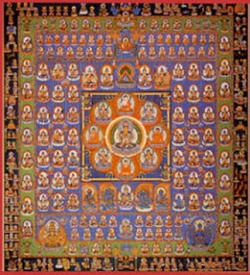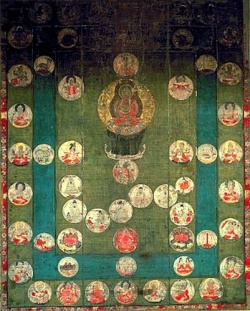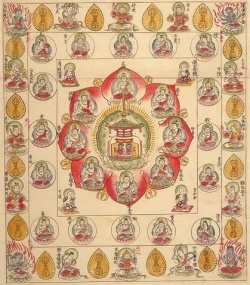Expression of Mandala
The Mandala is a manifestation of the spirit and the world of Mahavairocana Buddha. Kobo Daishi said in his report to the Imperial court,
“It is hard to realize Universal Reality, therefore this is a way to help people to understand by using pictures.”
It is almost impossible to explain the state of awakening with words, therefore in Shingon Buddhism, the mandala is effective in helping people to feel the reality of the teachings.
Mandala is a Sanskrit word literally meaning “circle”; in the Mahavairocana Tantra, this is explained further: Manda means essence while la signifies accomplishment.
To accomplish the essence of the universal truth is the goal of Buddhism and through this awakening, one can achieve sokushin jobutsu (enlightenment in this body).
The Mandala is like a wheel on a vehicle that assists you to go forward, one may go wayward without fully understanding the skillful means of the Buddha’s teaching within the mandala.
In order for us to understand universal reality, one viewpoint may not be sufficient.
There are four types of Mandala studied in Shingon Buddhism:
Maha Mandala (the Great Mandala)
This is the Mandala that Mahavairocana, various Buddhas, Bodhisattvas, and other deities are depicted together.
There are countless numbers of beings in the world and all of them are sharing the life and virtues of the Dharmakaya.
This mandala expresses the interdependence of beings in this world.
Samaya Mandala (symbolic Mandala)
Samaya means vow. This mandala depicts symbols of the Buddha’s various vows instead of drawing their figures.
For example, a stupa is drawn in the center to symbolize Mahavairocana, or a sword to symbolize Fudo Myoo.
From this viewpoint, it is easier for us to understand each deity’s vow and significance.
There are objects like metal, rocks, soil, etc. in this world.
These objects are inanimate, but they are used as symbols for us to understand reality.
Dharma Mandala (Written form Mandala)
Dharma means teaching. Instead of figures or symbols, Siddham Sanskrit characters are used to express the deities.
For example, the Sanskrit letter ‘A’ symbolizes Mahavairocana, ‘Hrih’ symbolizes Avalokitesvara, ‘Ha’ symbolizes Ksiitgarbha, and so on.
The spirit of the Dharma Mandala represents the manifestation of the Dharmakaya, encompassing all things in this universe.
Karma Mandala (activity mandala)
Karma means action or activity; therefore this mandala is not in an art form, but is often carved onto metal or stone in a three-dimensional viewpoint.
The meaning of this Mandala is that all of the phenomenal activities, including our own actions, the movement of plants, clouds, stars, and seasons are all activities of Mahavairocana Buddha in itself.
Thus, all movements or actions are expressed as the Karma Mandala.
Just like there are a thousand remedies for a thousand symptoms, all things are invaluable and everything is interdependent.
Not only are the physical and oral teachings the voice of Mahavairocana, but the sound of waves and the crash of waves hitting the shore are also the voice of Mahavairocana.
When you try to look at the Buddhas in the Maha Mandala for example, you naturally try to understand the Buddha’s mind, teaching and actions.
These four mandalas are not independent, but rather they are all interconnected and are just four different views of the same Mandala.


